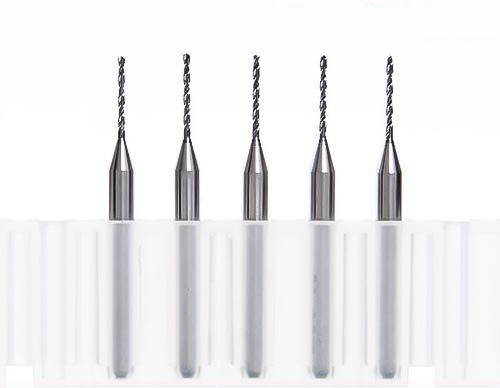
When PCBs Meet "Pocket Cannons": A Survival Guide for Solid Carbide Drills in the Electronics Industry
In a bustling electronics contract manufacturing workshop, 28-year-old technician Xiao Li is peering through a microscope, adjusting drilling parameters. The 0.15mm solid carbide drill bit in his hand is pushing the limits of machining a 5G communication substrate—this is the third batch this month scrapped due to drilling defects.
Scenes like this play out daily across the electronics manufacturing industry. As an "invisible champion" of the tooling industry, solid carbide drill bits are undergoing a remarkable transformation, transitioning from traditional metal machining to precision electronics manufacturing.
The via hole diameter on modern smartphone motherboards has now broken the 0.1mm barrier—about one-seventh the width of a human hair. High-speed steel (HSS) drill bits at this scale are like trying to embroider with an iron rod, whereas tungsten-cobalt carbide materials maintain cutting-edge sharpness and dimensional stability even at 20,000 RPM.
When twelve-layer PCB stacks reach a thickness of 3.2mm, the drill bit must penetrate each layer of copper foil with surgical precision while avoiding burrs. A test report from a Japanese electronics firm showed that after processing 20 PCBs, carbide drill bits maintained a hole diameter deviation of ≤0.003mm—precision beyond the reach of conventional tooling.
Faced with ceramic substrates and metal-based composite boards, we developed custom-coated carbide drill bits for a sensor manufacturer, improving their processing yield from 67% to 92%. The secret? Fine-tuning cobalt content and edge treatment to match different material properties.

When grain size breaks the 0.5μm threshold:
| Coating Type | Application | Friction Coefficient | Heat Resistance |
|---|---|---|---|
| TiAlN | Standard FR-4 boards | 0.45 | 800°C |
| AlCrN | Metal-based composite boards | 0.38 | 900°C |
| DLC+WS₂ | Ceramic substrates | 0.22 | 1200°C |
| Graphene Composite | Extra-thick multilayer boards | 0.18 | 1500°C |

Cobalt-based binders are evolving into multi-alloy systems:
Carbide drill bits for the electronics industry often feature a 35° spiral angle—a rare parameter in traditional machining but highly effective in preventing PCB delamination. Think of it as "intelligent navigation" for chips, ensuring smooth evacuation.
To prevent high-speed rotation from burning hole walls, electronic-grade drill bits incorporate a 0.02–0.05mm reverse taper. This seemingly imperceptible detail is crucial in avoiding copper foil burrs at hole entry.
A contract manufacturer in Suzhou calculated that while high-quality carbide drill bits cost 30% more per unit, when factoring in tool change times and improved yield rates, the per-million-hole processing cost actually drops by 18%. This is why savvy buyers are shifting their focus from unit price to per-hole cost efficiency.
| Material Type | Recommended Drill Type | Optimal Speed (RPM) | Coating Choice | Tool Life (Holes Per Bit) |
|---|---|---|---|---|
| FR-4 Epoxy Resin Boards | Solid Carbide (Tungsten-Cobalt) | 120,000–150,000 | TiAlN | 1,800–2,200 |
| Aluminum Heat Sink Boards | Low-Cobalt Carbide | 80,000–100,000 | DLC | 600–800 |
| Ceramic Substrates | Diamond-Coated Drill | Ultrasonic Vibration Mode | Nano-Diamond | 300–500 |
| Flexible Copper Foil Boards | Ultrafine-Grain Carbide | 180,000+ | Composite Coating | 2,500–3,000 |
| Stainless Steel Casings | HSSE Cobalt High-Speed Steel | 30,000–50,000 | TiN | 200–300 |
Experienced operators summarize it like this:
For a 0.3mm drill bit:
150,000 RPM + 0.6m/min feed rate
This combination ensures both efficiency and minimal hole burrs.
Q1: Carbide drill bits are expensive—are they worth it?
→ If monthly production exceeds 50,000 units, they are a must. For small batches, try HSSE first.
Q2: Why do HSS drill bits sometimes produce smoother holes?
→ In soft materials, carbide bits may "bite" too aggressively—reduce speed to fix this.
Q3: Can carbide drill bits replace all other drills?
→ No! They struggle with soft aluminum due to chip adhesion.
As domestic precision engraving machines surpass 180,000 RPM, traditional drill bits suffer from imbalance issues. Our asymmetrical land design has reduced tool vibration alarms by 40% for a major drone motherboard manufacturer.
As aluminum-core + FR-4 "sandwich" structures gain traction, we adjusted drill point angles from 130° to 118° to prevent interlayer delamination—turning micro-adjustments into a new normal for electronic tooling customization.
A Japanese enterprise is testing RFID-embedded drill bits, enabling real-time monitoring of temperature and vibration data for predictive tool changes—ushering in a new era of "talking drill bits" for factory management.
In a world where hole depth tolerances are a thousand times thinner than a human hair, the evolution of solid carbide drills mirrors the progress of the electronics industry. From nano-grains in a materials lab to moisture-proof packaging in e-commerce warehouses, every detail is a battle for micron-level perfection. As our drills quietly spin inside 5G base stations in New York, ECU units in Munich, and medical devices in Tokyo, their 0.01mm precision is redefining the value of precision manufacturing.

 We like to do design according to all the customers' requirements, or offer them our new designs. With strong OEM/ODM capabilities, we can fill your sourcing demands.
We like to do design according to all the customers' requirements, or offer them our new designs. With strong OEM/ODM capabilities, we can fill your sourcing demands.